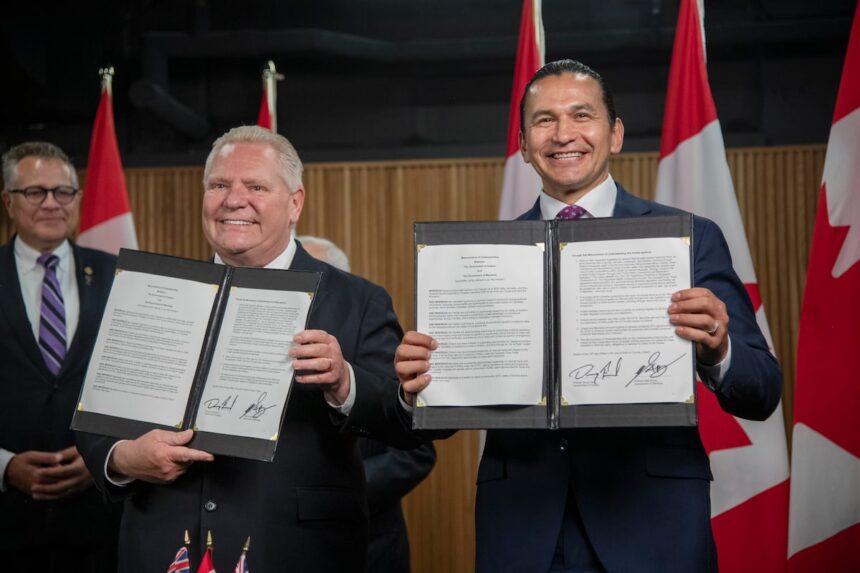If politicians were to write a Canadian economics textbook, the chapter on interprovincial trade might be permanently marked “under revision.” As Canada Day celebrations fade and summer barbecues continue, few Canadians realize they’re paying a premium on everything from beer to construction materials because of invisible borders between provinces.
The Canadian Free Trade Agreement (CFTA) was supposed to tear down these barriers when it launched in 2017, replacing the aging Agreement on Internal Trade. Seven years later, progress remains frustratingly incremental despite repeated promises from premiers and the federal government.
“We’re essentially operating as 13 separate economies rather than a unified market of 40 million people,” says Trevin Stratton, chief economist at Deloitte Canada. “The economic cost is staggering – anywhere between $50 billion and $130 billion annually, depending on which study you reference.”
To put that in perspective, the higher estimate represents roughly 7% of Canada’s entire GDP – money that could otherwise flow to Canadian households through lower prices and higher wages.
The persistence of these barriers seems particularly puzzling when you consider Canada has aggressively pursued international trade agreements. We’ve enthusiastically opened our borders to European and Pacific Rim trading partners while maintaining regulatory walls between Alberta and Ontario.
The barriers themselves often sound trivial until you examine their real-world impact. Different provincial trucking regulations mean shipping companies need to adjust their trucks’ wheel base when crossing certain provincial boundaries. Construction contractors face different certification requirements in each province, preventing skilled workers from moving to where they’re needed most. Even something as simple as beer faces a complex web of provincial monopolies and distribution regulations.
Alcoholic beverage restrictions alone cost Canadians approximately $1.2 billion annually according to a C.D. Howe Institute report. When the Supreme Court upheld New Brunswick’s right to restrict beer imports from Quebec in the 2018 “Free the Beer” case, it essentially validated provinces’ constitutional authority to maintain these barriers.
Trevor Tombe, professor of economics at the University of Calgary and a leading researcher on internal trade, says the problem goes beyond specific regulations. “The real challenge isn’t identifying barriers – we know what they are. The problem is political will. Each province jealously guards its regulatory authority, and local special interests benefit from maintaining these protections.”
The federal government has attempted to apply pressure through the Regulatory Reconciliation and Cooperation Table established under the CFTA, but progress has been piecemeal. While some advances have been made in areas like occupational health and safety standards and transportation regulations, major barriers persist in professional licensing, agricultural marketing, and government procurement.
For Canada’s businesses, especially small and medium enterprises, these barriers create genuine hardship. Kelsey Ramsden, CEO of Vancouver-based construction firm Belvedere Place Development, describes the challenges her company faces: “We have projects in three provinces, and it’s like operating in three different countries. The paperwork, certifications, and registration requirements triple our administrative burden.”
That burden ultimately translates to higher costs for consumers. Economists estimate Canadians pay between 2-15% more for many goods and services than they would in a truly unified market.
Some provinces have taken bilateral steps to address these issues. Alberta, British Columbia, and Saskatchewan created the New West Partnership Trade Agreement in 2010, which has eliminated many barriers between these provinces. Similarly, Ontario and Quebec have signed cooperation agreements to harmonize regulations in specific sectors.
The pandemic briefly catalyzed progress when provinces agreed to recognize each other’s essential worker credentials and streamlined procurement processes for medical supplies. But that momentum has largely faded as the immediate crisis subsided.
Perhaps most frustratingly, public awareness of these barriers remains low, creating little political pressure for change. While international trade disputes make headlines, interprovincial trade barriers operate in relative obscurity despite their larger economic impact.
“This is a perfect example of concentrated benefits and diffuse costs,” explains Robin Shaban, director at Vivic Research, an economic consulting firm. “A small number of protected businesses benefit enormously from these barriers, while the costs are spread across millions of consumers who individually pay just a little more – but collectively pay billions.”
The path forward isn’t entirely bleak. The CFTA does include mechanisms for ongoing negotiation and reconciliation of regulations. And some provinces have unilaterally eliminated barriers, recognizing their own economic interest in free internal trade.
Manitoba, for instance, passed legislation in 2019 to unilaterally recognize occupational certifications from other provinces and territories. The results have been positive – increased labor mobility without the regulatory chaos critics feared.
Business groups have increasingly mobilized around this issue. The Canadian Chamber of Commerce launched its “Free Enterprise” campaign earlier this year, focusing specifically on interprovincial trade barriers. “We need to make this a kitchen table issue,” says Perrin Beatty, the Chamber’s president. “Canadians need to understand they’re paying a hidden tax every time they shop because of these barriers.”
For a country that prides itself on free trade and economic integration, the persistence of internal barriers represents a peculiar blind spot in Canadian economic policy. As we look toward post-pandemic economic recovery, addressing these barriers offers a rare opportunity for growth that doesn’t require new spending – just the political courage to dismantle protectionist policies that no longer serve their purpose.
The irony isn’t lost on economists: Canada vigorously negotiates access to foreign markets while maintaining barriers within its own borders. Until that changes, Canadians will continue paying a premium for the privilege of living in a supposedly unified economic federation.






